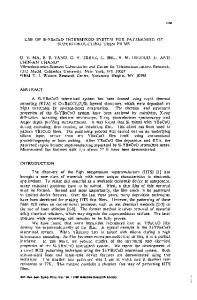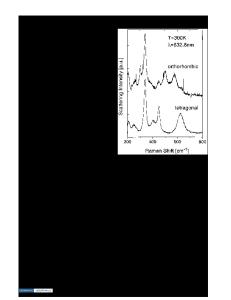Superconducting YBaCuO thin Films by Cu-Ion Implantation
- PDF / 405,860 Bytes
- 6 Pages / 420.48 x 639 pts Page_size
- 37 Downloads / 347 Views
SUPERCONDUCTING YBaCuO THIN FILMS BY Cu-ION IMPLANTATION Kevin M. Hubbard, Nicole Bordes, Michael Nastasi, and Joseph R. Tesmer Los Alamos National Laboratory, Los Alamos, NM 87545 ABSTRACT We have investigated the fabrication of thin-film superconductors by Cu-ion implantation into initially Cu-deficient Y(BaF 2 )Cu thin films. The precursor films were co-evaporated on SrTiO3 substrates, and subsequently implanted to various doses with 400 keV 63 Cu 2+. Implantations were preformed at both LN 2 temperature and at 380"C. The films were post-annealed in oxygen, and characterized as a function of dose by four-point probe analysis, X-ray diffraction, ion-beam backscattering and channeling, and scanning electron microscopy. It was found that a significant improvement in film quality could be achieved by heating the films to 380"C during the implantation. The best films became fully superconducting at 60-70 K, and exhibited good metallic R vs. T. behavior in the normal state. INTRODUCTION High quality YBa2Cu307-8 thin films are now routinely grown at a number of laboratories worldwide, and research is now focusing on the development of practical applications such as IR detectors, rf cavities, and micro-electronic devices. In the field of device fabrication, the prospects for integration of the high-temperature oxide superconductors as circuit interconnects, SQUIDs, hybrid semiconductor/superconductor circuits, etc., appear promising. The possibility of device fabrication employing standard ion-beam technology has already been demonstrated by several research groups [ 1-3]. In one experiment, Nastasi et al.[3] implanted Y ions into a thin film of composition (BaF2)2Cu3. Upon annealing, the precursor material became an insulator, but the Y-implanted material become a superconductor with an onset temperature of 85 K, and Tc,r=0 - 35 K. This result raises the possibility that patterned superconductors could be fabricated by direct writing, using existing focused ion-beam technology. We have performed a complementary series of experiments, using Cu-ion implantation into Cu-deficient Y(BaF2)Cu thin films. The motivation for implanting Cu, despite the increased dose required, was the reduction in nuclear stopping power and sputtering yield associated with the lighter projectile. The decreased sputtering yield implies that, depending on the initial Cu concentration, less of the as-deposited film will be sputter etched during the implantation. The decrease in nuclear stopping power leads to an increase in the incident-ion range, allowing greater flexibility in choosing the film thickness. Furthermore, any ions reaching the film/substrate interface will cause less damage to that critical region. The electrical and structural properties of the as-deposited and implanted films were investigated as a function of implant dose using a variety of analytical techniques. EXPERIMENTAL PROCEDURE Thin films of Y(BaF2)Cu were deposited by electron-beam co-evaporation onto substrates of SrTiO 3 . The substrates remained at ambient temperature
Data Loading...











